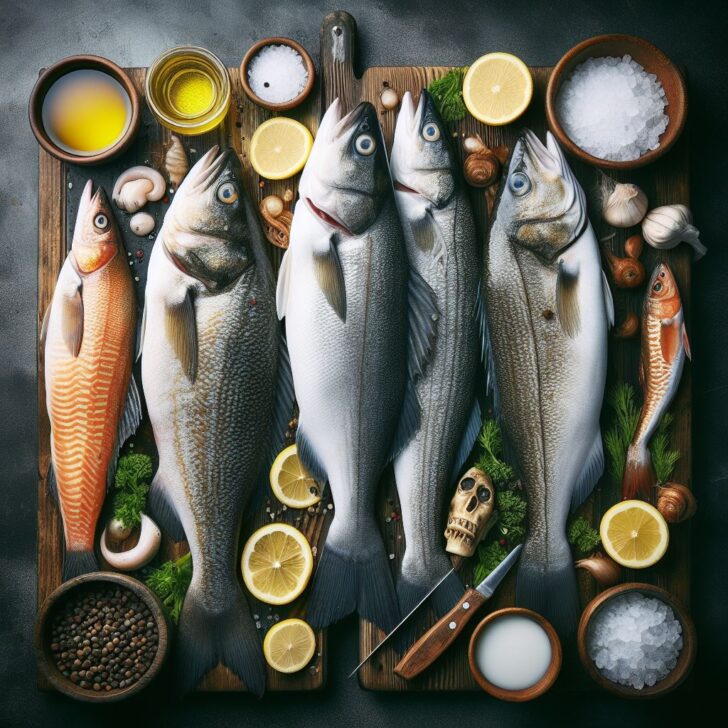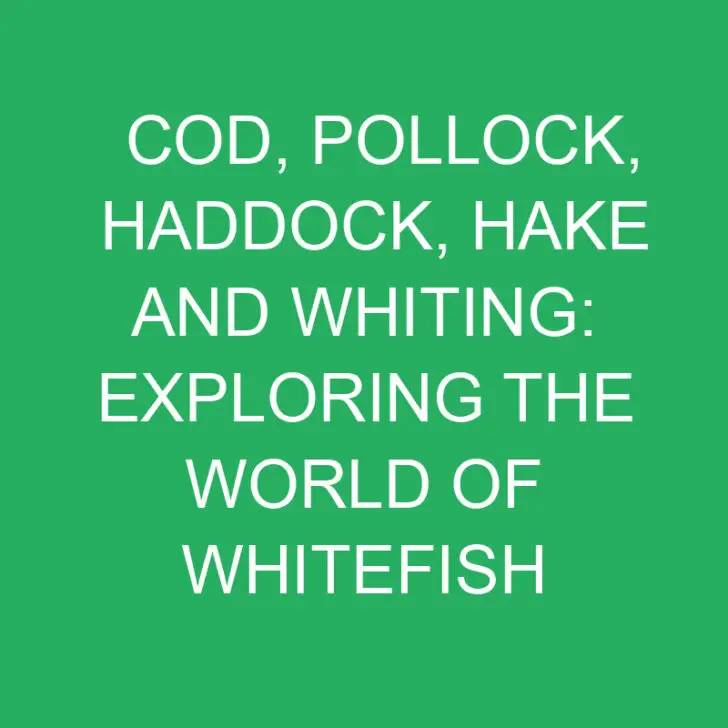Whitefish, a diverse group of species found in oceans around the world, play a crucial role in the global seafood industry and are prized for their mild flavor, flaky texture, and versatility in cooking. Among the most well-known whitefish species are cod, pollock, haddock, hake, and whiting. In this article, we’ll take a closer look at each of these species, exploring their characteristics, habitats, culinary uses, sustainability considerations, and more.

Post Contents
1. What is Cod?
Cod (Gadus morhua) is one of the most iconic and widely consumed whitefish species, known for its firm, white flesh and delicate flavor. Found in cold waters of the North Atlantic, cod is a staple in cuisines around the world and is prized for its versatility in cooking. It can be baked, broiled, fried, or grilled and is commonly used in dishes such as fish and chips, fish stews, and fish cakes.
Habitat, Culinary Uses, and Sustainability of Cod
Habitat: Cod is found in the North Atlantic Ocean, ranging from the coastal waters of New England and Canada to the waters off Iceland, Norway, and the United Kingdom. It prefers cool temperatures and typically inhabits rocky bottoms, reefs, and offshore banks.
Culinary Uses: Cod is prized for its mild flavor and flaky texture, making it suitable for a wide range of culinary applications. It is commonly used in dishes such as cod fillets with lemon and herbs, cod fish tacos, and cod chowder.
Sustainability: Cod populations have faced significant declines in recent decades due to overfishing and environmental factors. As a result, many fisheries have implemented strict management measures to protect cod stocks and promote sustainable harvesting practices.
2. What is Pollock?
Pollock (Pollachius pollachius and Pollachius virens), also known as Alaska pollock or walleye pollock, is a highly abundant and commercially important whitefish species found in the North Pacific and North Atlantic oceans. It is known for its mild flavor, flaky texture, and affordability, making it a popular choice for seafood products such as fish sticks, surimi, and imitation crabmeat.
Habitat, Culinary Uses, and Sustainability of Pollock
Habitat: Pollock is found in cold waters of the North Pacific and North Atlantic, ranging from the Bering Sea and Gulf of Alaska to the waters off Iceland, Norway, and Greenland. It is a highly migratory species that inhabits both coastal and offshore areas.
Culinary Uses: Pollock is valued for its versatility and affordability, making it a staple ingredient in a variety of dishes. It can be baked, broiled, grilled, or fried and is commonly used in recipes such as pollock fish tacos, pollock burgers, and pollock stir-fry.
Sustainability: Pollock is considered one of the most well-managed fisheries in the world, with robust stock assessments and strict catch limits in place to ensure long-term sustainability. However, concerns remain about bycatch and habitat impacts associated with pollock fishing operations.
3. What is Haddock?
Haddock (Melanogrammus aeglefinus) is a popular whitefish species closely related to cod, known for its sweet flavor, flaky texture, and white flesh. It is widely consumed in North America and Europe and is a favorite choice for traditional fish and chips.
Habitat, Culinary Uses, and Sustainability of Haddock
Habitat: Haddock is found in the North Atlantic Ocean, ranging from the coastal waters of New England and Canada to the waters off Iceland, Norway, and the United Kingdom. It prefers cool temperatures and typically inhabits sandy or gravelly bottoms.
Culinary Uses: Haddock is prized for its delicate flavor and firm texture, making it suitable for a variety of culinary preparations. It can be baked, broiled, fried, or grilled and is commonly used in dishes such as haddock fillets with breadcrumbs, haddock chowder, and haddock fishcakes.
Sustainability: Haddock populations have fluctuated over time due to fishing pressure and environmental changes. However, many fisheries have implemented measures to promote sustainable harvesting practices and ensure the long-term viability of haddock stocks.
4. What is Hake?
Hake (Merluccius spp.) is a group of closely related whitefish species found in oceans around the world, known for their mild flavor, moist texture, and white flesh. While several species of hake exist, the most commonly consumed varieties include European hake (Merluccius merluccius) and Pacific hake (Merluccius productus).
Habitat, Culinary Uses, and Sustainability of Hake
Habitat: Hake species are found in a variety of ocean habitats, ranging from the coastal waters of Europe and North America to the waters off South America, Africa, and Australia. They typically inhabit continental shelves and slopes, where they feed on small fish and crustaceans.
Culinary Uses: Hake is prized for its mild flavor and flaky texture, making it suitable for a wide range of culinary applications. It can be baked, broiled, fried, or grilled and is commonly used in dishes such as hake en papillote, hake fish cakes, and hake tacos.
Sustainability: Hake populations are subject to varying levels of fishing pressure depending on the region and species. While some hake fisheries are well-managed and sustainable, others face challenges related to overfishing and bycatch. It is important for consumers to choose hake products from responsibly managed fisheries to support sustainable seafood practices.
5. What is Whiting?
Whiting (Merlangius merlangus), also known as English whiting or European whiting, is a species of whitefish found in the North Atlantic Ocean, particularly in the waters off Europe. It is valued for its delicate flavor, flaky texture, and affordable price, making it a popular choice for fish and chips and other seafood dishes.
Habitat, Culinary Uses, and Sustainability of Whiting
Habitat: Whiting is found in the North Atlantic Ocean, ranging from the coastal waters of Europe to the waters off Iceland, Norway, and the United Kingdom. It typically inhabits sandy or muddy bottoms and can be found at various depths, from shallow coastal waters to deeper offshore areas.
Culinary Uses: Whiting is prized for its mild flavor and soft texture, making it suitable for a variety of culinary preparations. It can be baked, broiled, fried, or poached and is commonly used in dishes such as whiting fillets with lemon butter sauce, whiting fish cakes, and whiting fish pies.
Sustainability: Whiting populations have fluctuated over time due to fishing pressure and environmental changes. While some whiting fisheries are well-managed and sustainable, others face challenges related to overfishing and habitat degradation. It is important for consumers to choose whiting products from responsibly managed fisheries to support sustainable seafood practices.
Conclusion
In conclusion, cod, pollock, haddock, hake, and whiting are all valued for their mild flavor, flaky texture, and versatility in cooking. Whether used in traditional fish and chips, seafood stews, or innovative culinary creations, these whitefish species play a significant role in global cuisine and the seafood industry.
However, ensuring the sustainability of whitefish stocks is crucial to safeguarding the health of marine ecosystems and supporting the livelihoods of fishermen and coastal communities. By making informed choices and supporting responsibly managed fisheries, consumers can enjoy delicious whitefish dishes while contributing to the preservation of ocean biodiversity for future generations.
